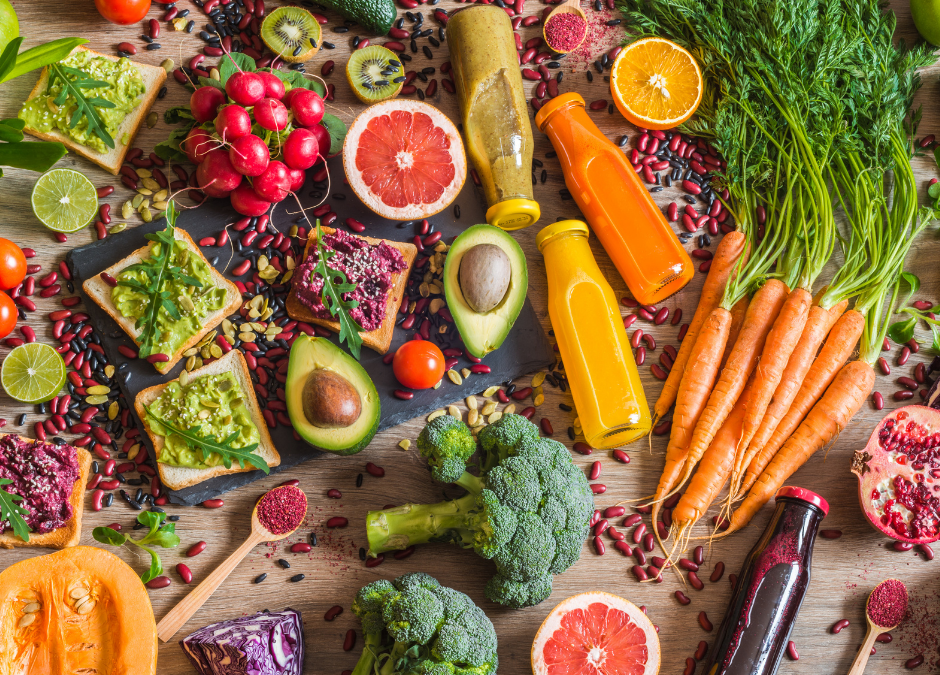
by lennie | Feb 4, 2022 | News, Uncategorized
We all know that it is always important to nourish your body with clean, organic and unprocessed foods, however during times of spiritual growth or awakening (Spiritual awakening is a term given to describe a subjective experience in which an individual’s ego transcends their ordinary, finite sense of self to encompass a wider, infinite sense of truth or reality.) it is even more important that your body is nourished with foods to support your changing vibration. Eating certain foods are also important during times of change, times of awakening and times of high emotional stress.
As your vibration level moves up in frequency, it can cause your energy to feel displaced, shaky or even unstable. You may even start experiencing bodily sensations, vivid dreams or feel sensitive towards others. During this time, it is important that you nourish your body with foods that are going to not only support you through this process but also support your pineal gland.
The pineal gland is the “seat of consciousness” and is often referred to as the third eye. It is responsible for our dreams, visions and being able to connect us with our higher purpose or source energy. The Pineal Gland has other functions in the body too, however from a more spiritual or esoteric approach, the pineal glad is truly how we awaken into our own consciousness and raise our vibration.
If you are looking to support or enhance your intuition, refocus your energy or need some help with ascension symptoms, here are 5 foods that will help support you:
1. Cold pressed Extra Virgin Olive or Coconut Oil
Healthy fats like those found in olive and coconut oil not only support brain and nervous system function but they also help us to expand our intuition. Often when you first come into your awakening, you may feel anxious or even depressed as you try to adjust to the changes. Eating a diet rich in these fats can help to calm you and keep you balanced through the process.
These fats are also stabilising and will help you to connect with Mother Earth. They can also increase your intuitive connection with nature.
2. Raw Cacao
Cacao is not only high in nutrients and antioxidants but it is also believed to help support the functioning of the pineal gland and enhance your intuition. Raw cacao is also a potent detoxifier and can help shift toxic energy out of your body and aura. It is also highly energizing and can help to stabilise energy levels throughout the day. Cacao can also help to elevate your mood and help you to calm the thoughts in your mind, making it perfect for meditation or mindfulness practices.
3. Beets
Beets help to detox the body of heavy metals and can assist in the cleansing of the pineal gland. Beets are also very grounding and can help you to feel more centered and balanced, especially if you are suffering from ascension symptoms or just feeling ‘out of touch’ with reality.
They can also help you to stay spiritually and emotionally strong around people who may be draining or when you are feeling sensitive to energy.
4. Herbs
There are so many wonderful herbs that support ascension, intuition and awakening. Fresh herbs and herbal teas have such a strong and powerful vibration themselves, so use your intuition to guide you to the right herb at the right time. Herbs can help you to expand your consciousness, heal your body, enhance your psychic abilities and raise the frequency of your vibration. In fact, herbs are amazing at helping you to move through into a higher level of consciousness.
Certain herbs can also help you deal with ascension symptoms and the opening of the chakras. You can read more about this here.
5. Water
Staying hydrated is always important, but during times of ascension it is crucial. Water helps you to detox negative energy and emotions out of your body and also helps to clear toxins.
During times of spiritual growth sometimes the pains and wounds of the past are also uncovered in order to be released. Staying hydrated can help release some of these emotions and can aid in the letting go process.
Staying hydrated also supports the functioning of your brain which in turn, supports the health of the pineal gland and your nervous system.
Water also helps to keep the energy moving throughout your body and can help keep your energy levels up.
Download PROVIDE A MEAL app and feed someone today! 


by lennie | Feb 2, 2022 | Foodtraditions, News
If Jan. 1 wasn’t quite the annual reset you had been hoping for, you may rejoice now by cooking for the Lunar New Year. For the Year of the Tiger, starts on Feb. 1, and the inaugural banquet commences the night time before. In China and different Asian international locations that understand the vacation, including Singapore, Vietnam and South Korea, the festivities can ultimate for 2 weeks, and the ingredients frequently signify guarantees for a higher 12 months ahead. But the instant praise is some thing scrumptious to consume, whether or not you’re making ready a banquet or simply one dish.
1. Peking Duck With Honey and Five-Spice Glaze
– A spotlight of eating place banquets, this dish may be made at home, too, mainly with streamlined strategies from Kay Chun. It continues with the way of life of serving entire chicken to sign abundance. Additionally, it tastes more unique than fowl and seems like a party in each of the cooking method and in serving.
2. Nonya Hokkien Stir-Fried Noodles – The long noodles signify lengthy life, and there are countless versions of Cantonese noodles. This Singaporean version, crowned with egg ribbons and crisp shallots, comes from Sharon Wee, the writer of “Growing Up in a Nonya Kitchen.” She shows topping it with highly spiced sambal belacan, a warm sauce made savory with shrimp paste.
3. Thit Heo Kho Trung (Pork and Eggs in Caramel Sauce) -The rich combination of beef and eggs receives its savory taste from fish sauce and a bit sweetness from coconut water and caramel, which additionally brings a welcome sour edge. Its commonly served with the dish over steamed rice and with pickled bean sprout salad to provide a fresh contrast.
4. Tang Yuan – The sticky texture and spherical form of those Chinese New Year dessert dumplings signify own circle of relatives unity, and consequently promise togetherness for the 12 months ahead. With the soft bite of a marshmallow and a nougat-like sesame filling, those rounds are served in a candy ginger soup. They’re clean to shape and freeze well, so that you can put together a massive batch straight away and consume them in the course of the holiday season.
5. Mandu The Korean New Year, Seollal, is honoured with tteok mandu guk, a steaming soup full of sticky rice cakes, which one is meant to consume a good way to see their subsequent birthday. Mandu, dumplings, aren’t necessary, however they flavor scrumptious withinside the broth, mainly whilst crafted from scratch the use of this recipe from Julya Shin and Steve Joo.
6. Pancit Palabok (Rice Noodles With Chicken Ragout and Shrimp) In the Philippines, noodles for durability tackle many forms, and this dish is a few of the richest. Finely shredded fowl simmers right into a aromatic sauce to thicken it, and plump shrimp pinnacle the noodles, in conjunction with boiled eggs and crunchy chicharron.
Download PROVIDE A MEAL app and feed someone today! 


by lennie | Jan 22, 2022 | Vegan
Plant foods are often a decent source of protein and of real benefit in helping to chop back animal proteins within the diet whether you’re an omnivore, vegetarian or a vegan. Here are a listing of plants that are great for protein!
1. Quinoa
Quinoa may well be a seed and you will find white, red, black or mixed varieties. 100g of quinoa (cooked weight) will provide almost 4g protein, but it’s also called an entire protein which means it contains all 22 amino acids, making it a wonderful alternative to carbohydrates like rice and couscous.
2. Pulses
A pulse is basically an seed that grows during a pod, and this therefore includes all beans, peas and lentils. These make a decent, low-fat and affordable source of plant protein and provide many variety. Different pulses include:
Lentils including Puy, green, and red: around 8-9g of protein per 100g
Chickpeas, including hummus: 7g of protein per 100g
Garden peas – around 7g per 100g
Beans, including black-eyed, pinto, butter, cannellini, soya, edamame and kidney: between 7-10g protein per 100g
Baked beans do count as an honest source of protein but keep a watch fixed on the salt content: 5g per 100g.
Tofu
Tofu, or tofu, springs from soya and just 100g of tofu provides 8g protein. Tofu is incredibly versatile because it’ll be cooked in some ways, including baking and stir-frying, yet as blending it into soups to create them creamier and better in protein.
3. Nuts and seeds
Nuts and seeds are again very versatile and could beused with meals or as a snack to verify adequate protein, and energy, is maintained throughout the day. variety of the only nut and seed proteins include:
Hemp seeds – 5g per heaped tablespoon
Ground linseed – 3g per heaped tablespoon
Almonds – 3g of protein for every six almonds
Walnuts – around 3g of protein for every three whole walnuts
Pumpkin seeds – 4g per tablespoon
Pistachios – just over 1g of protein over 10 pistachios
Cashew nuts – 3g per 10 cashew nuts
Brazil nuts – 4g per six Brazil nuts
Peanut butter and nut butters too as another convenient protein source, but read the label to create sure they’re 100% nuts and do not have any added oils, salt or sugars. One heaped tablespoon of smooth paste provides just over 3g of protein.
4. Chia seeds
Just one tablespoon of chia seeds will provide almost 2g of protein, which they is utilized in breakfasts, sprinkled over salads and soups, or as a healthy, protein-rich dessert. They also work as an excellent replacement to egg in vegan cooking as they’re hydrophilic and mighttherefore expand when soaked in water for about twenty minutes.
5. Buckwheat
Buckwheat is actually a seed that’s high in both protein and fibre, with 100g providing about 5g of protein, and it’s also gluten-free. Buckwheat is becoming increasingly popular and could be found as flakes, groats, pasta and flours making it an excellent addition to a vegan diet.
6. Oats
Whilst oats are a flowery carbohydrate, providing slow energy release, they’re also an outstanding source of protein packing 10g per 100g.
7. Brown and wild rice
Whilst primarily a carbohydrate, brown and wild rice do contain adequate levels of protein, around 4g per 100g, and they’re also a superb source of fibre.
8. Other grains
Some slightly less known grains can also be accustomed raise your protein:
Spelt – over 5g of protein per 100g
Teff – over 4g of protein per 100g
Amaranth – over 4g of protein per 100g
Sorghum – over 8g of protein per 100g
9. Vegetables
Vegetables also offer a surprising amount of protein including:
Asparagus – almost 2g of protein per six spears
Avocado – over 1g per ½ an avocado
Broccoli – almost 3g per 80g broccoli
Brussels sprouts – around 2g per 80g Brussels sprouts
Cauliflower – 1.5g per 80g serving
Jerusalem artichokes – over 1g of protein per 80g
Kale – almost 2g per 80g serving
Spinach – 2g per 80g serving
Sweetcorn – over 2g for every three heaped tablespoons
Download PROVIDE A MEAL app and feed someone today! 


by lennie | Jan 22, 2022 | News, Uncategorized
Past studies hinted that coffee might have a dark side, newer research suggests that it may actually have health benefits.
How so? It’s hard to look at just one aspect of diet and connect it to a health condition because so many other factors that could play a role. For example, early research on coffee didn’t always take into account that heavy coffee drinkers also tended to use tobacco and be sedentary.
When newer studies adjusted for such factors, they found a possible association between coffee and decreased life. Coffee may offer some protection against:
- Parkinson’s disease
- Type 2 diabetes
- Liver disease, including liver cancer
- Heart attack and stroke
Coffee still has potential risks, mostly due to its high caffeine content. For example, it can temporarily raise blood pressure. Women who are pregnant, trying to become pregnant or breastfeeding need to be cautious about caffeine. High intake of boiled, unfiltered coffee has been associated with mild increase in cholesterol levels.
The bottom line is that your coffee habit is probably fine and may even have some benefits. But if you have side effects from coffee, such as heartburn, nervousness or insomnia, consider cutting back!
Download PROVIDE A MEAL app and feed someone today! 


by lennie | Dec 11, 2021 | Food Tips, Uncategorized

![]()
![]()







